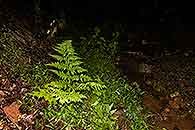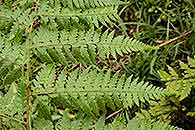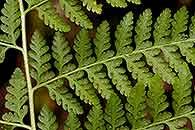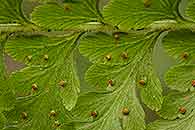Microlepia speluncae (L.) T. Moore
Synonyms |
Polypodium
speluncae L. |
|---|---|
Common name |
|
Description |
Rhizome widely creeping, branched, 5-10 mm diameter; rhizome hairs few, pale, up to 4 mm long. Fronds widely spaced, membranous. Stipe up to 1 m long, brown, glabrous at maturity. Lamina yellow-green, 0.4-1.8 × 0.1-1.4 m, 3-4(-5) pinnatifid, triangular to ovate in outline. Pinnae alternate, narrowly oblong to oblong-lanceolate, up to 60 x 21 cm, 2–3-pinnate to 2–3-pinnatifid, acute; pinnules alternate, up to 13 x 6 cm; ultimate segments oblong-lanceolate, 4-12 x 3-4 mm, with rounded apex and lobed margins, both surfaces and costules with soft short hairs. Rhachis thinly set with minute soft hairs, eventually glabrous. Sori 2-10(-20) per segment, circular, 1 mm diameter, intramarginal, situated at the end of the veins, which shows as a hydathode on the upper surface; indusium cup-shaped and facing outwards. |
Notes | It can be distinguished from Hypolepis sparsisora by having a thinly pubescent lamina and pinna that stand in the same plane as the main axis. Microlepia speluncae favours shaded areas whereas Hypolepis sparsisora lives in areas with high-light conditions. |
Derivation | speluncae: from spelunca, a cave, referring to the sporangia sheltered in the cup-shaped indusium or less likely to the deeply shaded habitat of this fern. |
Habitat | In moist conditions in semi-deciduous forest, evergreen forest, swamp forest and marshes, mostly in shaded habitats. |
Distribution worldwide | Widespread in Africa, also in the Madagascan region, pantropical. |
Distribution in Africa |
Angola, Benin, Botswana, Burundi, Cameroon, Central African Republic, Congo, Dem. Republic of Congo, Equatorial Guinea (incl. Bioko), Ethiopia, Gabon, Ghana, Guinea, Ivory Coast, Kenya, Liberia, Malawi, Mozambique, Namibia, Nigeria, Rwanda, Sierra Leone, South Africa, Sudan and South Sudan, Swaziland, Tanzania , Togo, Uganda, Zambia, Zimbabwe. |
Growth form |
Terrestrial. |
Literature |
|






